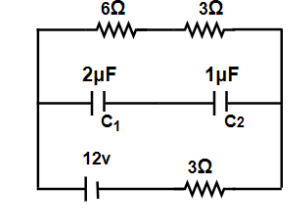
The charges stored in each capacitor ${C_1}$ and ${C_2}$ in the circuit shown below are.

$A.6\mu C,6\mu C$
$B.6\mu C,3\mu C$
$C.3\mu C,6\mu C$
$D.3\mu C,3\mu C$
Answer
216.3k+ views
Hint: Find out the current flowing through the circuit which is given by the ratio of voltage to the equivalent resistance $I = \dfrac{V}{R}$ . Voltage is the product of current and resistance which need to be calculated across the capacitors. The capacitors are connected in series so the effective capacitance will be evaluated from $C = \dfrac{{{C_1}{C_2}}}{{{C_1} + {C_2}}}$ . Now, charge is the product of capacitance and voltage which can be found by substituting the data. The charge of both the capacitors will be the same due to their series connection.
Complete step-by-step answer:
Consider the capacitors as fully charged, then current is not drawn from the cell.
The equivalent resistance of the circuit is \[6 + 3 + 3 = 12\]
Current of the circuit is given by,
$I = \dfrac{V}{R}$
Given that, $V = 12V$
$I = \dfrac{{12}}{{12}}$
$I = 1A$
Hence the current in the circuit is 1A.
Now the potential across the capacitors is
$V = IR$
$V = 6I + 3I + 3I$
$V = 9V$
The net capacitance between them is
$C = \dfrac{{{C_1}{C_2}}}{{{C_1} + {C_2}}}$
$C = \dfrac{2}{{2 + 1}}$
$C = \dfrac{2}{3}\mu F$
Now the equivalent charge is given by
$Q = CV$
$Q = \dfrac{2}{3} \times 9$
$Q = 6\mu C$
The capacitors are in series so the charge will be the same on both capacitors that is $Q = 6\mu C$.
The correct option is A.
Note: the effective capacitance in parallel grouping is given by,
$C = {C_1} + {C_2} + {C_3}$
For n identical capacitors in series, ${C_e} = \dfrac{C}{n}$
In parallel,${C_e} = nC$ .
Complete step-by-step answer:
Consider the capacitors as fully charged, then current is not drawn from the cell.
The equivalent resistance of the circuit is \[6 + 3 + 3 = 12\]
Current of the circuit is given by,
$I = \dfrac{V}{R}$
Given that, $V = 12V$
$I = \dfrac{{12}}{{12}}$
$I = 1A$
Hence the current in the circuit is 1A.
Now the potential across the capacitors is
$V = IR$
$V = 6I + 3I + 3I$
$V = 9V$
The net capacitance between them is
$C = \dfrac{{{C_1}{C_2}}}{{{C_1} + {C_2}}}$
$C = \dfrac{2}{{2 + 1}}$
$C = \dfrac{2}{3}\mu F$
Now the equivalent charge is given by
$Q = CV$
$Q = \dfrac{2}{3} \times 9$
$Q = 6\mu C$
The capacitors are in series so the charge will be the same on both capacitors that is $Q = 6\mu C$.
The correct option is A.
Note: the effective capacitance in parallel grouping is given by,
$C = {C_1} + {C_2} + {C_3}$
For n identical capacitors in series, ${C_e} = \dfrac{C}{n}$
In parallel,${C_e} = nC$ .
Recently Updated Pages
Wheatstone Bridge Explained: Working, Formula & Uses

Young’s Double Slit Experiment Derivation Explained

JEE Atomic Structure and Chemical Bonding important Concepts and Tips

JEE Amino Acids and Peptides Important Concepts and Tips for Exam Preparation

Electricity and Magnetism Explained: Key Concepts & Applications

Chemical Properties of Hydrogen - Important Concepts for JEE Exam Preparation

Trending doubts
JEE Main 2026: Application Form Open, Exam Dates, Syllabus, Eligibility & Question Papers

Derivation of Equation of Trajectory Explained for Students

Hybridisation in Chemistry – Concept, Types & Applications

Understanding the Angle of Deviation in a Prism

Understanding Collisions: Types and Examples for Students

How to Convert a Galvanometer into an Ammeter or Voltmeter

Other Pages
JEE Advanced Marks vs Ranks 2025: Understanding Category-wise Qualifying Marks and Previous Year Cut-offs

Understanding Atomic Structure for Beginners

Ideal and Non-Ideal Solutions Explained for Class 12 Chemistry

Degree of Dissociation: Meaning, Formula, Calculation & Uses

Understanding Electromagnetic Waves and Their Importance

Understanding the Electric Field of a Uniformly Charged Ring




